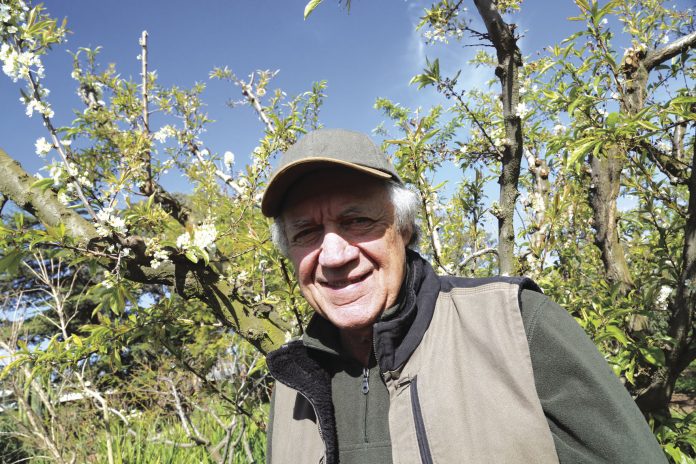
A Morgan Hill draft General Plan Update aims to keep future housing development at its current and—to city officials and many residents—preferred density by encouraging new single-family homes on existing farmland on the east side of town.
And the farmers who have maintained these agricultural uses for decades—including the Mariani and Guglielmo families—are OK with that, as long as some of the area’s agricultural history is preserved for future generations.
Later this month, the Morgan Hill City Council will consider the draft General Plan Update that introduces this and a number of other new land use policies in order to maintain the city’s low-density housing charm.
Specifically, the draft document currently on the table will allow new homes in the currently agricultural “East of 101 Area Plan Overlay,” which is bound by Half Road, Diana Avenue, Condit Road and Hill Road.
The five-member council is scheduled to discuss the latest draft of the Morgan Hill 2035 General Plan Update at the July 20 meeting, with approval an as-yet undetermined staff recommendation scheduled for July 27, according to City Manager Steve Rymer. The document, when approved, will set guidelines for how the city will grow from now until 2035. It includes designations for properties currently outside the city limits, but which the council and city staff will likely determine are necessary to accommodate future growth.
By state law, cities in California are required to update their General Plans every 10 years.
East of 101
Properties included in this land use area of the General Plan update sit just outside the city’s Urban Service Area, so the proposed city plan for the neighborhood will require approval by the Santa Clara County Local Agency Formation Commission.
Most of this area is agricultural, planted with orchards and vineyards. But the General Plan proposal—which is supported by these farmland owners—aims to eventually transform the area into a low-density residential neighborhood with a variety of housing types, complete with “services and amenities to serve new residents…so daily needs can be met close to home,” the draft states.
The plan also aims to preserve some of the area’s farming heritage by incorporating “historical agricultural uses.” Andy Mariani, owner of Andy’s Orchard—which is included in the East of 101 overlay—said, for example, this could be a “preservation orchard” that represents the valley’s once prolific crops, a community garden or an educational resource that can be shared with the community at large or students at nearby Live Oak High School.
Development in this area would require a master plan or specific plan before it can proceed.
Incompatible uses
Mariani urged the council to adopt this aspect of the General Plan update at a discussion meeting in May. He and other longtime farmers spoke of how difficult it is to continue farming in an area where residential uses increasingly encroach.
“In actuality, I lost money the last three years,” said Mariani, who has run his cherry orchard on Half Road for 60 years. “The housing development around us—chimneys, pavement, exhaust—all contribute to higher winter temperatures…With the schools and surrounding homes, tasks like harvesting and spraying are much more problematic…Half Road has become a commuter route from the hills on the east side. Eventually, we’ll be boxed in on all sides by urban development.”
He added that his family is “not just a bunch of wealthy landowners eager to develop their land.” But Mariani cautioned that if the city doesn’t adopt the East of 101 overlay in the current General Plan draft, farmers will be forced by the economic hardship to sell their property, thereby eliminating any chance to preserve the agricultural heritage of the area.
He later clarified that the overlay proposed in the current General Plan draft isn’t likely to occur for another 20 years. “As a family, we have to plan for 20 years down the road,” he said.
Gary Guglielmo, whose family has owned Guglielmo Winery and maintained the vineyards on East Main Avenue for 90 years, said farming in this area “doesn’t pencil out to a profit” anymore.
“The wine industry is very competitive,” Guglielmo said at the May 25 council meeting. “The future growth of our business is agritourism (which will) draw more people to Morgan Hill…It doesn’t make sense from a business standpoint to plant new vines—it has and will sit vacant.”
John Telfer, a real estate broker and owner of South County Realty, presented the council with data that shows the city is running out of vacant land available for future single-family housing, which seems to offer the charm that most Morgan Hill residents prefer. Therefore, encouraging such housing in the area east of 101 is crucial.
Proposed housing in the General Plan 2035 draft’s east of 101 overlay allows for single-family housing lots between 7,000 and 18,000 square feet, Telfer said.
“The property owners are comfortable” with the proposal, he added. Recent council discussions on the General Plan update—a process that started in Morgan Hill more than two years ago—have entertained the possibility of keeping the overlay area designated a rural county, and pursuing incorporation into the city limits when and if the property owners get a specific plan completed.
“The problem with that is, specific plans are very time intensive and very expensive,” Telfer said. “Nobody (among the property owners) would do that unless at least the General Plan had it.”
Long-term goals
With these and many more updates included in the draft document, the city council hopes to maintain a mix of 70 percent single-family housing and 30 percent multi-family. However, Telfer thinks that won’t be possible. The supply of property available for lower density housing is shrinking, and based on recent trends, LAFCO is unlikely to approve the future city boundary requests on which the General Plan housing vision relies.
The General Plan includes many more policies that identify future needs for commercial/industrial land uses, housing and transportation needs, downtown development, economic development and preservation of environmental resources.
The draft can be viewed at morganhill2035.org.







